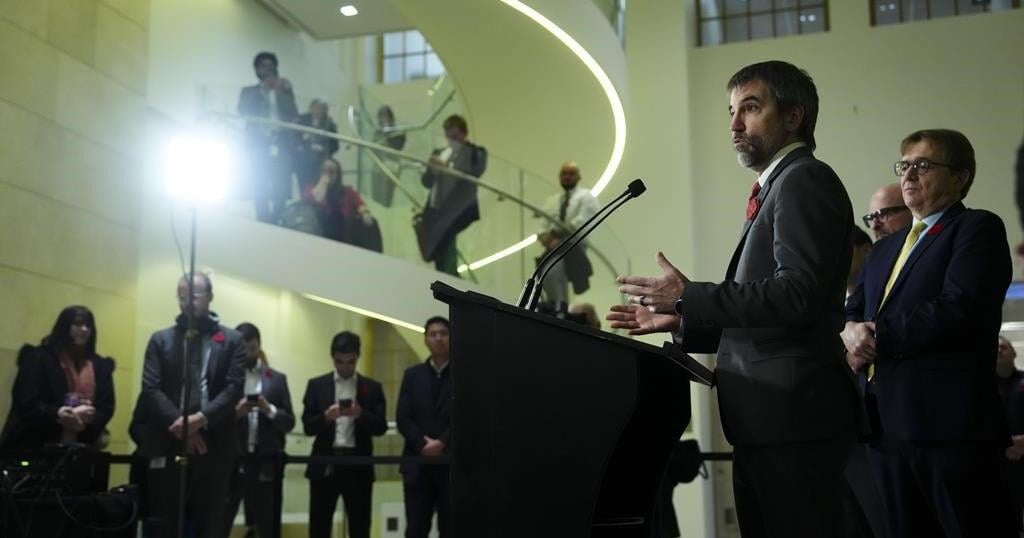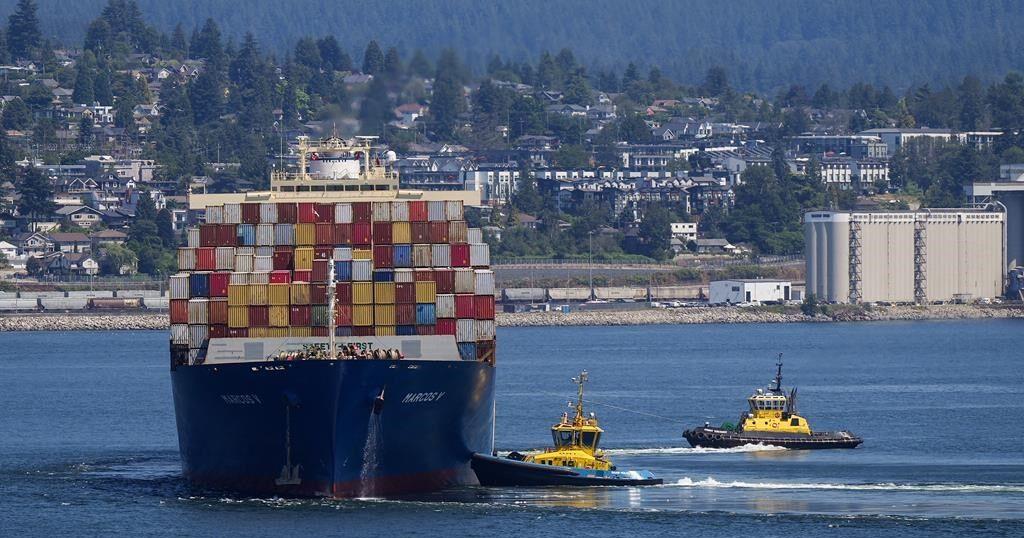VANCOUVER – Employers have locked out more than 700 unionized workers in the latest development in a labour dispute that the union says will shut down all ports in British Columbia until further notice.
The BC Maritime Employers Association said Monday that its “difficult decision” to impose the lockout came after the International Longshore and Warehouse Union Local 514 commenced “industry-wide strike activity” at employers’ terminals.
The employers association said in a release that the lockout in response to strike action would begin on the 4:30 p.m. shift on Monday and continue until further notice, but it would not affect grain or cruise operations.
“ILWU Local 514’s strike action has already begun to impact B.C.’s waterfront operations and strike activity can easily escalate, including a complete withdrawal of labour without notice,” the employers said in explaining its decision to lock out union members.
Local 514 said in an email response that members went to work as normal at 8 a.m. Monday, but an overtime ban was implemented and workers would “refuse to participate in technological change as their limited job action.”
A statement from the union on Monday in response to the lockout said employers have “deliberately and irresponsibly overreacted” to its overtime ban, which was aimed at restarting stalled talks that have been ongoing for almost two years.
Local 514 president Frank Morena said in the statement that the employers’ lockout is a “clear effort to force the federal government to intervene.”
Speaking in Parliament Monday, federal Labour Minister Steven MacKinnon reiterated that he spoke with both the employers and the union on the weekend and urged them to find a solution.
“It is their responsibility, and they need to do the work necessary to get an agreement,” MacKinnon said.
The minister’s comments come after questions by NDP parliamentary member Matthew Green.
“This blatant attempt to manipulate this Liberal government into undermining workers’ rights is an outrageous assault on free collective bargaining,” Green said in Parliament.
The employers association, however, said the only reason the lockout was triggered was because of strike action by the union.
Morena said the union’s negotiators are “ready to resume talks any time the BCMEA shows up.”
The two sides met for mediated talks last week, and Local 514 has accused employers of not showing up on the last day of scheduled talks on Thursday.
“Our union members have been trying since our contract expired March 31 of 2023 to reach a new collective agreement and have been more than patient in the face of BCMEA provocation, which continues today with a full-scale lockout,” Morena said in a statement Monday.
The union issued its notice of job action last Thursday in response to a “final offer” presented by employers a day earlier, an offer the association said would give a 19.2 per cent wage increase over a four-year agreement ending in 2027.
“The BCMEA’s final offer to the union represents our best effort to settle the dispute and move forward with an agreement that recognizes the skills and efforts of 730 hardworking forepersons and their families, while also ensuring Canada’s West Coast ports remain reliable and stable for the many customers and supply chain partners who conduct business there,” the association said at the time.
The association also said the offer would include a 16 per cent increase in retirement benefits, additional recognized holidays and an average $21,000 lump sum for eligible employees that includes back pay since the contract expired.
“Despite ILWU Local 514’s regrettable decision to destabilize Canada’s supply chain, the BCMEA’s comprehensive offer remains open until withdrawn,” the employers association said Monday.
In its response Sunday, the union said the proposal from the employers failed to address one of the key concerns for workers: a staffing requirement that addresses the implementation of port automation at facilities such as DP World’s Centerm container Terminal in Vancouver.
Local 514 said employers have “demanded the union agree to having technological change provisions of the Canada Labour Code that apply to all federally unionized workers waived in a new contract,” a demand that Morena called “ludicrous.”
“The idea that our union would waive provisions of the Canada Labour Code that protect not only ILWU Local 514 but all Canadian workers is absolutely outrageous,” Morena said in the statement Sunday.
Morena also said employers told the union that they would remove parts of the existing collective agreement — including retroactivity on wages as well as welfare and other benefit improvements — if the union did not accept its final offer presented Wednesday.
The employers, in response to Morena’s comments, disputed a number of points raised by the union leader.
The association said its final offer not only matched a deal reached last year with longshore workers to end a dispute that included a 13-day freeze at B.C. ports, but also included “additional elements” specifically for Local 514 members.
“The BCMEA is not requiring any concessions of the union in our final offer, nor is the final offer removing any items from the existing collective agreement,” the employers said.
The labour disruption in Vancouver, Canada’s largest port, has prompted concern from both political and business leaders.
In a joint written statement, Alberta Premier Danielle Smith and Transportation Minister Devin Dreeshen called on the federal government to “urgently intervene with binding arbitration” in future disputes, while also improving “its strategy for managing labour relations” in federally regulated transportation sectors.
“These ports export about $50 million worth of Alberta’s key commodities every day including agricultural, energy and manufacturing-related products,” the statement said. “A prolonged work stoppage will disrupt the movement of these products, backlog other transportation networks such as rail and trucking and damage the economies of Alberta and Canada.”
Chemistry Industry Association of Canada president Bob Masterson said in a statement that “this level of uncertainty further strains Canada’s reputation as a reliable trading partner,” while Fertilizer Canada urged government to legislate changes that would oblige service provisions to continue during strike or lockout in longshoring.
“We are once again on the brink of losing access to a critical trade corridor,” Fertilizer Canada president Karen Proud said in the statement, noting disruptions earlier this year when both major Canadian railways shut down due to labour strife.
“Potash fertilizer will be one of the hardest hit commodities,” she said. “We are asking both the BC Maritime Employers Association and the International Longshore and Warehouse Union Canada to come to a resolution and avoid a catastrophic shutdown.”
This report by The Canadian Press was first published Nov. 4, 2024.































